We have not seen the worst of the cold fronts yet, but June has been a chilly month nevertheless. The fan heater in the greenhouse is now timed to go on for 15 minutes every hour as soon as it gets dark. The Phalaenopsis in particular are looking a little worse for wear and have lost a number of leaves. Winter is also the time for orchid shows and I have three new aquisitions to show off in this post. Curiously enough, all three of these have bright yellow flowers. I must subconsciously be trying to add a little sunshine to the grey weeks ahead.
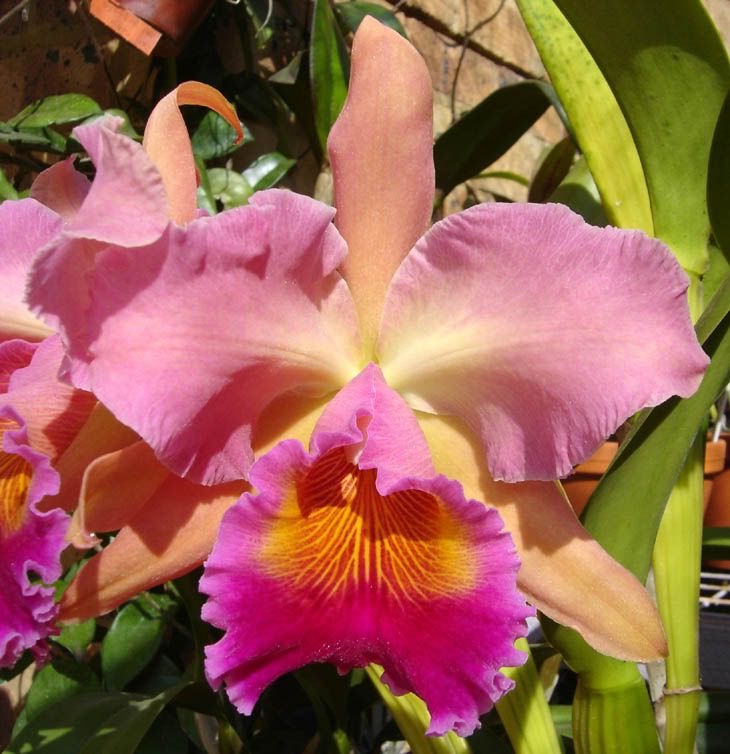
Laeliocattleya Antinea 'Copper King'. In 2003 I went to the greenhouses of MC Orchids looking for large pastel Cattleyas. Carol Erasmus, the friendly owner, suggested I take this plant, which had a very large new growth and seemed like a strong grower. Usually I'm quite wary of buying things without open flowers or exact knowledge of what they will look like, but I trusted Carol on this one. And I was so glad I did when it finally bloomed in September 2004. Since then it has flowered regularly from the newly matured pseudobulbs, usually at 9 month intervals. It truly is a royal addition to my collection. Each flower segment exceeds 10cm in length and is captivatingly coloured in shades of coral and peach.The labellum and general stature of this grex owes much to the rare Colombian Cattleya dowiana, which features prominently in its pedigree. A heady scent like hyacinths fills any room graced by its presence.
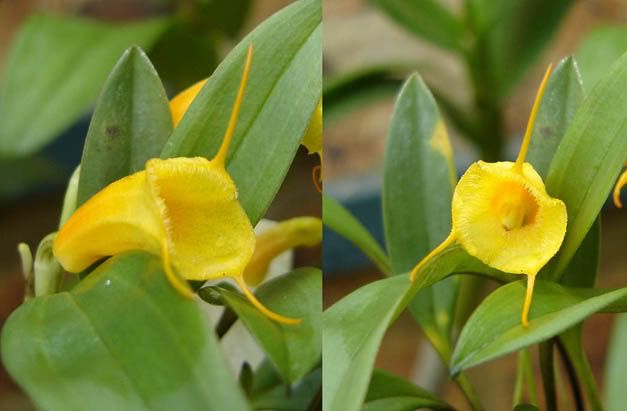
Masdevallia Orange Ice. Masdevallias are small cool growing orchids from the misty cloud forests of the Andes. This yummy newcomer looks good enough to lick, just like a citrus-flavoured ice lolly. The tubular structure formed by the fused sepals is covered with minute crystalline hairs on the inside, giving it a beautiful iridescent sheen.
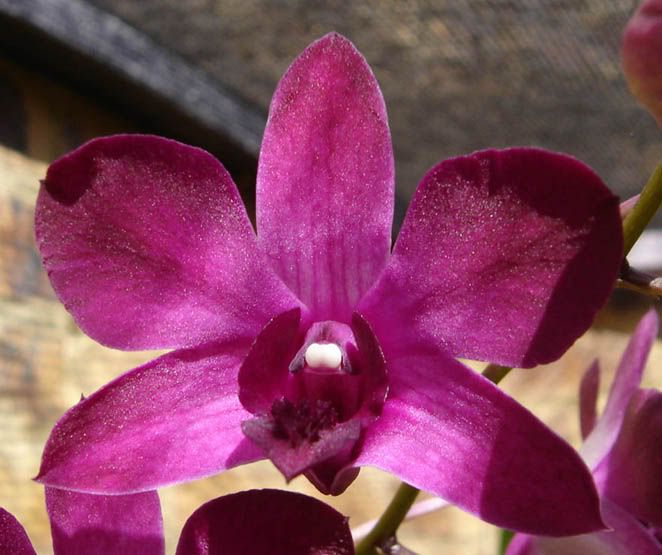
Dendrobium Dal's Glory x Blue Twinkle. This unregistered hybrid has produced two inflorescences this year, one from the newly matured and one from last year's growth. The buds on these flower spikes are taking a really long time to open, though. I suspect this is because I grow this hardcane Dendrobium under shade net outside, where it doesn't receive much warmth. I like to think that the cold temperatures make the flowers a tad darker and more longlasting had I grown it in the greenhouse. The white anther cap is unsual an makes a nice contrast to the rest of the flower.
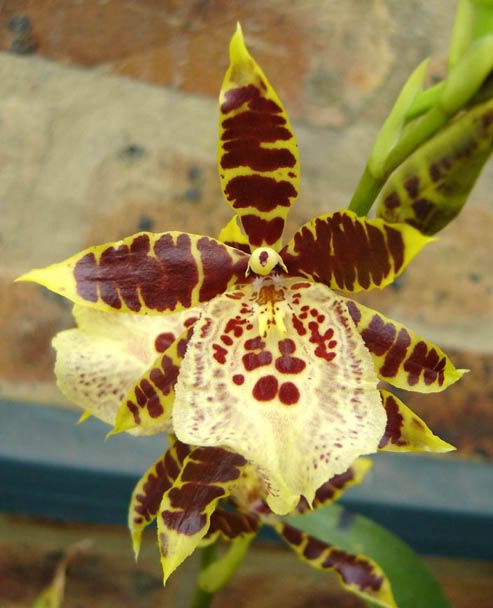
Degarmoara Flying High 'Stars & Bars'. This is where I believe popular taste in orchids is heading. The market is saturated with rounded pink and white Phalaenopsis, and people are looking for something modern and edgy. Degarmoara is a 'synthetic' modern hybrid between the three related genera Brassia, Miltonia and Odontoglossum, which were particularly popular in the Victorian Age. The tropical Brassia genes make the flowers large and starry/spidery, whereas the genes from the more temperate Odontoglossum and Miltonia have influenced the broad lip and barred patterning. These plants have attractive tropical-looking foliage and are tolerant of a wide range of conditions. I can really recommend it for anybody looking for an easy orchid with a lot of impact.
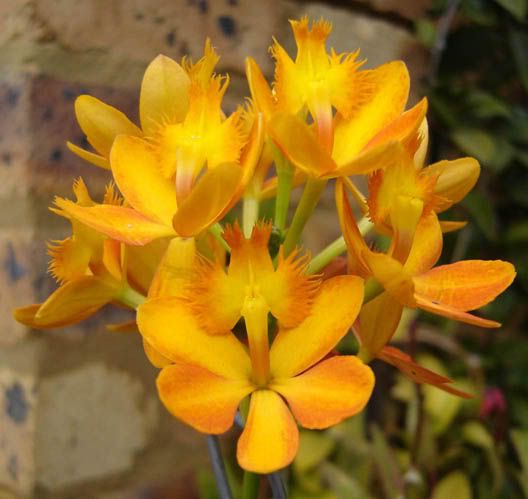
Epidendrum Pacific Girl. An irresistably yellow reedstem Epidendrum with some of the largest flowers I have ever seen on this kind of orchid. I got it from Afri-Orchids at the ONT show this year and really like the spoon-shaped petals artfully shaded with orange.
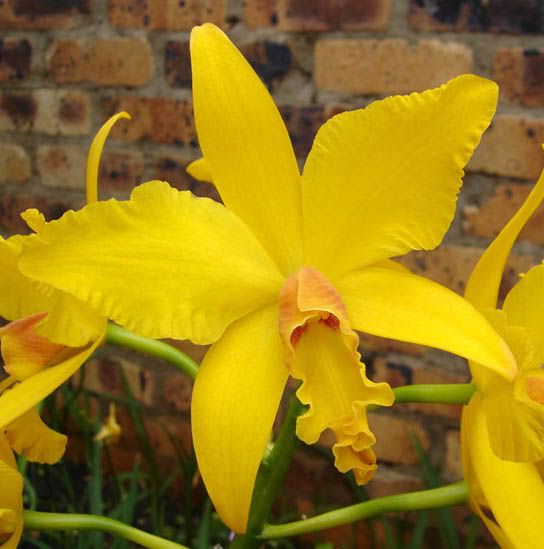
Potinara Jong Jou Moat. This is a brand new Asian grex comprising the four genera Sophronitis, Laelia, Brassavola and Cattleya. It is superb and I'm really pleased with it. The plant is quite tall with big, deep green leaves like a Cattleya, but with a long flower spike emerging from the sheath to carry the starry flowers well above the foliage like a Laelia. The flowers are sure to last well and have superb balance and colour intensity.
Sophrolaeliocattleya Seagulls Newton Abbot. This trigeneric hybrid was registered in 1982. Its parents are Sophrolaelia Psyche and Laeliocattleya Muriel Turner. I've reflowered this plant over several years now and have noticed an interesting phenomenon. If grown moist and in shade, the flowers and general appearance of the newest pseudobulb resemble Sophronitis coccinea, one of the plants in its ancestry. This orchid is found growing epiphytically in dark wet forests in southern Brazil. If I move it into a high light area with more restricted watering, the new pseudobulb and flowers more closely resemble those of the lithophytic Laelias in its ancestry, such as Laelia milleri and Laelia cinnabarina. Interesting to observe how the relevant sets of genes get switched on when the conditions change!


5 comments:
they are beautiful........the yellow one's especially :)
Read my post about the Orchid Society of Northern Transvaal's Winter Show. It explains a bit about why orchid collectors are all insane.
wat maak jy met jou plante as jy weg van die huis af is? wie vertrou jy genoeg om na hul om te sien?
Orchids thrive on benign neglect and won't come to any harm if you lock up and go away for a month. You'll see some shrivelling, but they recuperate again so quickly. For extended periods of time it's better to have someone keep an eye on them - I'll usually ask my mother to water them every now and again. Certain orchid nurseries also have a babysitting service and will look after your plants for a small fee.
hmm orchid babysitting hmmm i sense a money making plan coming together......do you need to know lots to do it?
Post a Comment